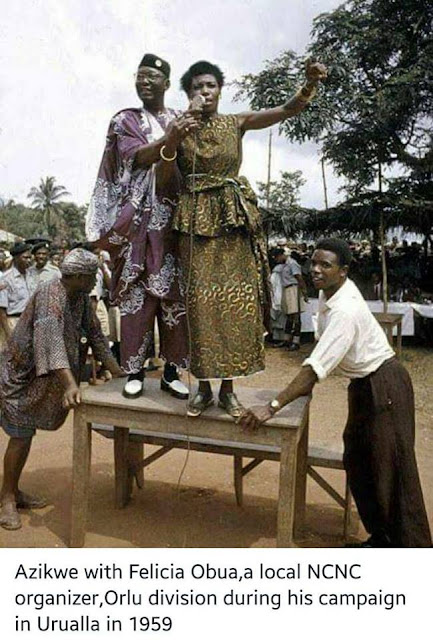Obasanjo Legacy: Lest We Forget
Adura_ngba: Obasanjo Legacy: Lest We Forget
--------------------------------------------------------------------------------
THE ECONOMY PRE-1999
Near Collapse of Economic and Social Infrastructure
• Slow Growth in GDP – 1.19% in 1999
• High Double-Digit Inflation in the range of 20 – 25%
• Loose Fiscal Policy with fiscal deficits averaging 3.5% of GDP
• Low growth in oil sector due to lack of investment – 7.5% in 1999
• Huge debt overload – external and domestic debt 70% of GDP resulting in difficulty in debt servicing
The Economy SINCE 1999
• FDI and Portfolio inflows more than doubling every year – about US$7bn in 2006; non-oil exports grew by 24% in 2006 and China and India becoming preferred partners.
• In 2006, the Nigerian economy grew by 7% (GDP growth rate). Inflation rate dropped from 17% to 10% by September 2006
• In 2006, the non-oil sector, especially agriculture, grew by 8% up from 6.5% in 2005 (almost twice as fast as the oil sector)
• Nigeria has the most profitable Stock Market in the world with an average Return on Investment (ROI of over 31%)
• Stable prices (exchange rate, inflation) and stronger banking system powering NSE; thousands of Nigerians are making money out of the capital market; NSE capitalization expected to be about US$100bn in 2008, ahead of Egypt and second only to JSE
• The Pension Reforms Act 2004 established for Nigeria a new and contributory pension scheme for both the private and the public sector. Pension Fund now in excess of N600bn
• 21 companies with market capitalization of US$1bn and above. There are 22 companies with such profile in West Africa, out of which 21 are in Nigeria – none in 1999.
AGRICULTURE SINCE 1999
• Growth rate in Agriculture sector increased from 2.9% in 1998 to 7% in 2005.
• Annual production of fingerlings and table fish increased from 2.0 million metric tones and 30,000 mt in 2004 to 50 million metric tones and 80,000 mt respectively in 2006.
• The Nations silo storage capacity increased by about 100,000 mt.
• The current growth rate is slightly higher than the 6% target set for the sector under NEEDS and NEPAD’s Comprehensive Africa Agricultural Development Programme
Agriculture, Water Resources
and Rural Development
SINCE 1999
• Water supply coverage increased from 35% to 65% between 1999 and 2007, hence increased food production through irrigation.
• A total of 2,170km rural feeder roads awarded for rehabilitation under the 2006 MDG Poverty Reduction Fund Release.
• The output of cash crop such as rice, cocoa and rubber also grew by 24%, 36% and 10% respectively.
• Cocoa production increased from 170,000 mt in 1999 to about 460,000 mt in 2006.
• Five new improved cassava varieties with potential yield of 30 - 80 tons/ha compare with the present yield of 12 - 15 tons/ha have been formerly released to farmers nationwide.
• 89 boreholes, 41 open wells, 24 micro earth dams, 480 tubewells and over 536 fish ponds constructed under the National Special Programme for Food Security (NSPFS)
• Annual production of cassava tubers increased from 35million metric tonnes in 2005 to over 49 million metric tonnes in 2005.
• 1,044 water pumps distributed
• Annual production of over 10,000 mt of assorted vegetables
• The construction of the Gurara water transfer project (capacity 850 million cubic metres), is a tremendous achievement in the development of dams and reservoirs.
• One of the global leaders in poultry production
Agriculture sector
Ensuring Food Security before 1999
• Scarcity of seedlings for farmers
• Unavailability of fertilizer to farmers
• Wastage of farm produce
• Lack of emphasis in agriculture
• High importation of locally produced food
items such poultry products, fruit juices, plantain chips, leading to undue pressure on
the Naira
Agriculture sector slide 8
ENSURING FOOD SECURITY SINCE 1999
• Presidential initiative on rice, livestock, cassava, vegetable oils, tropical fruits and tree crops have led to a significant boost in agricultural production
• Increased interest in agriculture due to improved government policies
• Improved allocation and distribution of fertilizer and farming implements
• Enhanced local and foreign markets for farm produce
• Increased in agricultural research funding
• Increased in output of major crops such as maize, millet, sorghum, rice, beans, yam, cassava etc.
ROAD & RAILWAY INFRASTRUCTURE
• Between 1999 and February 2007, FGN spent N116bn to complete 117 roads and bridges covering 4,747km
• Currently there are 118 new and on-going projects covering 632,428km with some attaining completion levels of 96.6%. Amount spent on this so far is N187.35bn
• Total length of road projects awarded (completed and on-going) since 1999 is 19,801.05km estimated at N229.019bn
• Some of the road dualisation projects are Ibadan-Ife; Benin-Asaba; Mile 3 diobu – P/Hacourt; Benin Bypass; Kaduna Refinery road; Onitsha-Owerre; Nyanya-Keffi; Ibadan-Ilorin; Benin-Warri; Lagos-Otta-Abeokuta; Kaduna Eastern Bypass; Abuja-Lokoja; East-West and Kano-Maiduguri
• Many roads are aklso under design for future dualisation, including Kano-Kongolam; Lokoja-Benin; Keffi-Jos; Akwanga-Lafia-Makurdi
• The plan is to dualize all major federal roads by 2020
Source: nairaland
--------------------------------------------------------------------------------
THE ECONOMY PRE-1999
Near Collapse of Economic and Social Infrastructure
• Slow Growth in GDP – 1.19% in 1999
• High Double-Digit Inflation in the range of 20 – 25%
• Loose Fiscal Policy with fiscal deficits averaging 3.5% of GDP
• Low growth in oil sector due to lack of investment – 7.5% in 1999
• Huge debt overload – external and domestic debt 70% of GDP resulting in difficulty in debt servicing
The Economy SINCE 1999
• FDI and Portfolio inflows more than doubling every year – about US$7bn in 2006; non-oil exports grew by 24% in 2006 and China and India becoming preferred partners.
• In 2006, the Nigerian economy grew by 7% (GDP growth rate). Inflation rate dropped from 17% to 10% by September 2006
• In 2006, the non-oil sector, especially agriculture, grew by 8% up from 6.5% in 2005 (almost twice as fast as the oil sector)
• Nigeria has the most profitable Stock Market in the world with an average Return on Investment (ROI of over 31%)
• Stable prices (exchange rate, inflation) and stronger banking system powering NSE; thousands of Nigerians are making money out of the capital market; NSE capitalization expected to be about US$100bn in 2008, ahead of Egypt and second only to JSE
• The Pension Reforms Act 2004 established for Nigeria a new and contributory pension scheme for both the private and the public sector. Pension Fund now in excess of N600bn
• 21 companies with market capitalization of US$1bn and above. There are 22 companies with such profile in West Africa, out of which 21 are in Nigeria – none in 1999.
AGRICULTURE SINCE 1999
• Growth rate in Agriculture sector increased from 2.9% in 1998 to 7% in 2005.
• Annual production of fingerlings and table fish increased from 2.0 million metric tones and 30,000 mt in 2004 to 50 million metric tones and 80,000 mt respectively in 2006.
• The Nations silo storage capacity increased by about 100,000 mt.
• The current growth rate is slightly higher than the 6% target set for the sector under NEEDS and NEPAD’s Comprehensive Africa Agricultural Development Programme
Agriculture, Water Resources
and Rural Development
SINCE 1999
• Water supply coverage increased from 35% to 65% between 1999 and 2007, hence increased food production through irrigation.
• A total of 2,170km rural feeder roads awarded for rehabilitation under the 2006 MDG Poverty Reduction Fund Release.
• The output of cash crop such as rice, cocoa and rubber also grew by 24%, 36% and 10% respectively.
• Cocoa production increased from 170,000 mt in 1999 to about 460,000 mt in 2006.
• Five new improved cassava varieties with potential yield of 30 - 80 tons/ha compare with the present yield of 12 - 15 tons/ha have been formerly released to farmers nationwide.
• 89 boreholes, 41 open wells, 24 micro earth dams, 480 tubewells and over 536 fish ponds constructed under the National Special Programme for Food Security (NSPFS)
• Annual production of cassava tubers increased from 35million metric tonnes in 2005 to over 49 million metric tonnes in 2005.
• 1,044 water pumps distributed
• Annual production of over 10,000 mt of assorted vegetables
• The construction of the Gurara water transfer project (capacity 850 million cubic metres), is a tremendous achievement in the development of dams and reservoirs.
• One of the global leaders in poultry production
Agriculture sector
Ensuring Food Security before 1999
• Scarcity of seedlings for farmers
• Unavailability of fertilizer to farmers
• Wastage of farm produce
• Lack of emphasis in agriculture
• High importation of locally produced food
items such poultry products, fruit juices, plantain chips, leading to undue pressure on
the Naira
Agriculture sector slide 8
ENSURING FOOD SECURITY SINCE 1999
• Presidential initiative on rice, livestock, cassava, vegetable oils, tropical fruits and tree crops have led to a significant boost in agricultural production
• Increased interest in agriculture due to improved government policies
• Improved allocation and distribution of fertilizer and farming implements
• Enhanced local and foreign markets for farm produce
• Increased in agricultural research funding
• Increased in output of major crops such as maize, millet, sorghum, rice, beans, yam, cassava etc.
ROAD & RAILWAY INFRASTRUCTURE
• Between 1999 and February 2007, FGN spent N116bn to complete 117 roads and bridges covering 4,747km
• Currently there are 118 new and on-going projects covering 632,428km with some attaining completion levels of 96.6%. Amount spent on this so far is N187.35bn
• Total length of road projects awarded (completed and on-going) since 1999 is 19,801.05km estimated at N229.019bn
• Some of the road dualisation projects are Ibadan-Ife; Benin-Asaba; Mile 3 diobu – P/Hacourt; Benin Bypass; Kaduna Refinery road; Onitsha-Owerre; Nyanya-Keffi; Ibadan-Ilorin; Benin-Warri; Lagos-Otta-Abeokuta; Kaduna Eastern Bypass; Abuja-Lokoja; East-West and Kano-Maiduguri
• Many roads are aklso under design for future dualisation, including Kano-Kongolam; Lokoja-Benin; Keffi-Jos; Akwanga-Lafia-Makurdi
• The plan is to dualize all major federal roads by 2020
Source: nairaland








Comments
Post a Comment